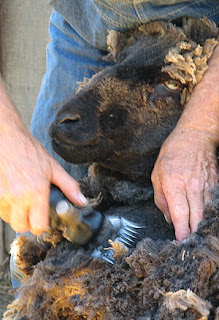Monday, May 28, 2007
Thursday, May 24, 2007
Killdeer (Charadrius wilsonia)
 The gravel road that leads to our farm is paralleled by a ditch for run-off water. In one section of the ditch water runs so fast that we had to fill it with rocks as big as your fist, to prevent erosion. Strange, but female Killdeer consider this the perfect place to lay eggs.
The gravel road that leads to our farm is paralleled by a ditch for run-off water. In one section of the ditch water runs so fast that we had to fill it with rocks as big as your fist, to prevent erosion. Strange, but female Killdeer consider this the perfect place to lay eggs. Killdeer are tall, slight birds that are related to Plovers – you can distinguish a Killdeer by its double black neck bands and golden-tawny tail feathers. Each spring the Killdeer come back to our area from wherever they’ve been during the winter (some range as far south as the West Indies and costal Peru) and look for a nesting site. We always have one or two along our ditch. The eggs are a dark speckled gray and blend in well with rocks.

Killdeer have a special behavior that’s pretty amazing to see. When you approach a nest the female will – very obviously - run a short distance away. As you get closer the bird will develop a broken wing, and struggle as if it is helpless (as in the photo). If you try to catch the bird it will continue to display and move just out of your reach - it’s all an attempt to draw you away from the nest. Killdeer are tireless at this game - they think our car is a threat and go into this display amost every time we drive down the road.
Wednesday, May 16, 2007
Shearing day
 Once a year, in the spring, the shearer passes through to Oldham County, stopping at a few farms that keep sheep and goats. We usually get a call the day before, and then scramble to get ready. The first task is always the same, get the sheep put up – it’s a precarious operation.
Once a year, in the spring, the shearer passes through to Oldham County, stopping at a few farms that keep sheep and goats. We usually get a call the day before, and then scramble to get ready. The first task is always the same, get the sheep put up – it’s a precarious operation.We have Merino sheep, a very skittish breed, but to our luck they are also creatures of habit. Each evening we feed them a little grain in their shed and the habit is set. They know when we enter the field gate with a bucket in hand that it’s time to eat. Usually they go in the shed and we simply lock the gate, but last evening something broke the rhythm of the routine and they would not go near their shed. So we went with plan B, which involves three people and six walking sticks. My wife, daughter and I went into the sheep field, strategically placed ourselves like wolves, and then with a walking stick in each hand, held at arms length, starting chasing the sheep around trying to herd them into their shed. To the sheep the walking sticks make us look very big. It’s a silly thing to see, three people running around chasing sheep – which can run very fast when they want to. We succeeded, one or two sheep at a time, and made ready for shearing.
 The shearer shows up in an old van, a farmer in bibbed overalls, weathered face, massive hands and just a few teeth in his head. He could walk into the 1930s and no one would think him out of place.
The shearer shows up in an old van, a farmer in bibbed overalls, weathered face, massive hands and just a few teeth in his head. He could walk into the 1930s and no one would think him out of place.Shearing usually goes like this: I go into the shed and pull a sheep out. That steps sounds simple, doesn’t it? But you have to remember, these sheep weigh about 130 or 140 pounds, they are scared, they are strong and they have a very low center of gravity. It’s a struggle during which I say many bad words in my mind. Next, we take off the old coats (see my previous article on Merino sheep for why they wear coats). Of course it’s difficult. Then the shearer goes to work.
 There is a phrase, “like sheep to the slaughter.” The transformation is surprising – in the hands of the shearer the sheep no longer struggle. Our shearer takes about five minutes to shear the wool into a fleece. It’s difficult to explain the process – the shearer practically peels the wool off the sheep, strategically leaving the belly wool on the outside. When he is done, we fit the sheep with a new coat, and then my wife “skirts” the fleece, that is, she picks around the outside edges removing the dirty belly wool – it is where the term “Skirting the issue” came from.
There is a phrase, “like sheep to the slaughter.” The transformation is surprising – in the hands of the shearer the sheep no longer struggle. Our shearer takes about five minutes to shear the wool into a fleece. It’s difficult to explain the process – the shearer practically peels the wool off the sheep, strategically leaving the belly wool on the outside. When he is done, we fit the sheep with a new coat, and then my wife “skirts” the fleece, that is, she picks around the outside edges removing the dirty belly wool – it is where the term “Skirting the issue” came from.Next, four more sheep…it’s a good job to have over.
Monday, May 07, 2007
Derby garden tradition
 Each year on Derby day, while everyone else is at Churchill Downs or getting ready for a party, we rework our flower garden. Eric, a friend of ours who was born with great garden Karma, leads us through the process. He brings plants, designs the layout and assigns our jobs – dig, weed, hoe, etc. My job is always the same – I haul compost (horse manure) for Michelangelo, 16 wheelbarrows this year.
Each year on Derby day, while everyone else is at Churchill Downs or getting ready for a party, we rework our flower garden. Eric, a friend of ours who was born with great garden Karma, leads us through the process. He brings plants, designs the layout and assigns our jobs – dig, weed, hoe, etc. My job is always the same – I haul compost (horse manure) for Michelangelo, 16 wheelbarrows this year. There’s no way to show a garden in a single photo. Eric chooses colors, textures, delicacies, and boldness. I can’t show the whole picture, so I’ll show just one flower.
There’s no way to show a garden in a single photo. Eric chooses colors, textures, delicacies, and boldness. I can’t show the whole picture, so I’ll show just one flower.Any good garden attracts life, but a thistle seed feeder helps - one of our feeder's most common visitors are American Goldfinchs - (Carduelis tristis). They are small birds - only about 5 inches long – sometimes known as the Wild Canary. The males are a stunning yellow and black.
Saturday, May 05, 2007
Spring Peepers

In the spring there are two sounds of the farm that I anticipate with relish. The first sound comes with the early spring rains, which in the evening bring an ancient and magical sound. The sound celebrates, in it’s purest sense, life. It is the mating calls of hundreds, if not thousands, of frogs. Most of the frogs we hear on these nights are tiny tree frogs, like the Cope's Gray tree frog. They fill the night with their love songs, as they have for perhaps 125 million years. Listen. 
The song is amazing, but it is endangered. Today biologist believe that 120 species of frogs have gone extinct just since the 1980s and that a third of current species are endangered. Enjoy their song, think about how ancient it is, and use a little less so they can keep singing.
And what is the other sound that I look forward to? You’ll have to wait a couple of weeks to hear the sound of a Lindon tree.

The song is amazing, but it is endangered. Today biologist believe that 120 species of frogs have gone extinct just since the 1980s and that a third of current species are endangered. Enjoy their song, think about how ancient it is, and use a little less so they can keep singing.
And what is the other sound that I look forward to? You’ll have to wait a couple of weeks to hear the sound of a Lindon tree.
Tuesday, May 01, 2007
Wild Turkey (Meleagris gallopavo)
 We woke to the sound of a wild turkey in our woods this morning. In early spring male turkeys (gobblers or toms) gobble to announce their presence to females and competing males. Supposedly you can hear them from up to a mile away. It’s a very rare treat to see a male in display, but we have a few times.
We woke to the sound of a wild turkey in our woods this morning. In early spring male turkeys (gobblers or toms) gobble to announce their presence to females and competing males. Supposedly you can hear them from up to a mile away. It’s a very rare treat to see a male in display, but we have a few times. We often see wild turkeys on our property in the spring and fall – females for the most part – sometimes alone and sometimes in groups.
Wild turkeys aren’t as large as there domesticated cousins - the average adult male only goes about 18 lbs.
There’s an interesting characteristic of domestic turkeys that my daughter and I discovered with the flock in Shakertown. If you whistle the right note they will gobble in response – they just can’t help themselves!


